Transportation Law in Australia: Regulations, Rules, and Case Studies
VerifiedAdded on 2023/04/20
|13
|779
|144
Report
AI Summary
This report provides a comprehensive overview of transportation law in Australia, encompassing road transport, rail safety, and heavy vehicle regulations. It details the roles of governmental bodies in maintaining the transport network, including funding and regulatory oversight. The report explores the Australian Road Rules, the Heavy Vehicle National Law (HVNL), and Australian Light Vehicle Standards Rules (ALVSRs). It also examines the Rail Safety National Law (RSNL) and provides a comparative analysis of the taxi and Uber industries, supported by case studies on safety, reliability, costs, and legal challenges. References to relevant sources are included to support the information presented.
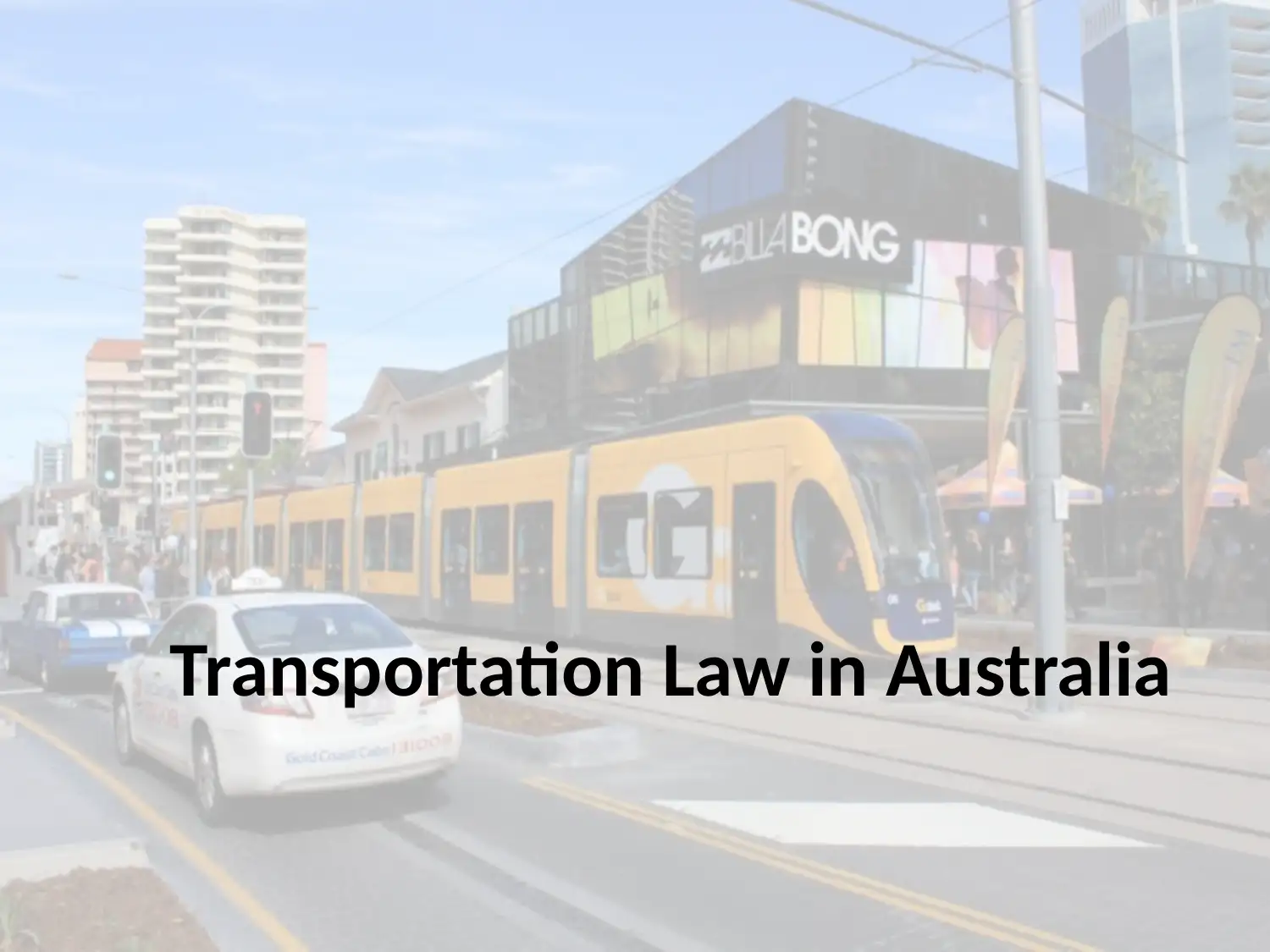
Transportation Law in Australia
Paraphrase This Document
Need a fresh take? Get an instant paraphrase of this document with our AI Paraphraser
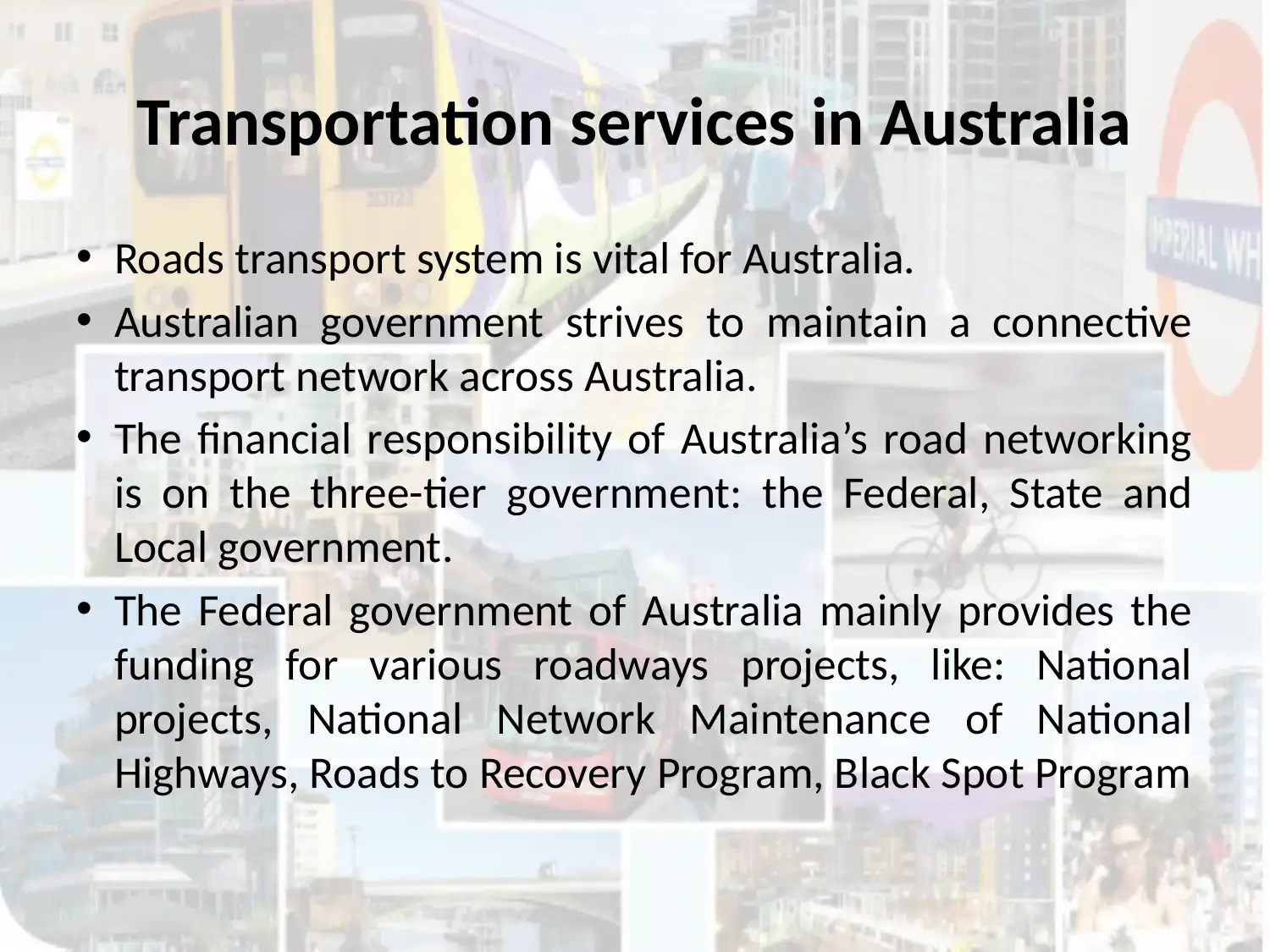
Transportation services in Australia
• Roads transport system is vital for Australia.
• Australian government strives to maintain a connective
transport network across Australia.
• The financial responsibility of Australia’s road networking
is on the three-tier government: the Federal, State and
Local government.
• The Federal government of Australia mainly provides the
funding for various roadways projects, like: National
projects, National Network Maintenance of National
Highways, Roads to Recovery Program, Black Spot Program
• Roads transport system is vital for Australia.
• Australian government strives to maintain a connective
transport network across Australia.
• The financial responsibility of Australia’s road networking
is on the three-tier government: the Federal, State and
Local government.
• The Federal government of Australia mainly provides the
funding for various roadways projects, like: National
projects, National Network Maintenance of National
Highways, Roads to Recovery Program, Black Spot Program
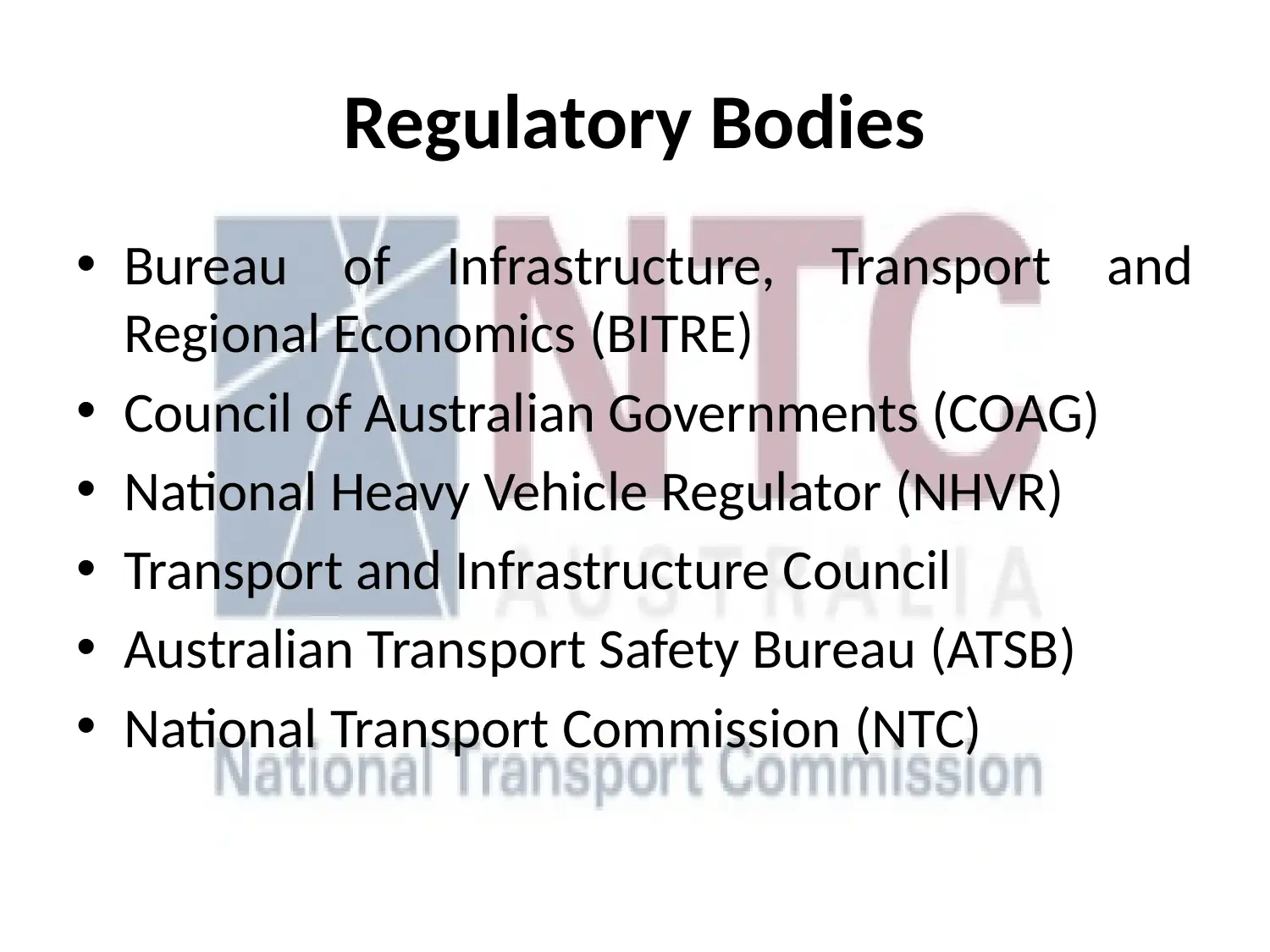
Regulatory Bodies
• Bureau of Infrastructure, Transport and
Regional Economics (BITRE)
• Council of Australian Governments (COAG)
• National Heavy Vehicle Regulator (NHVR)
• Transport and Infrastructure Council
• Australian Transport Safety Bureau (ATSB)
• National Transport Commission (NTC)
• Bureau of Infrastructure, Transport and
Regional Economics (BITRE)
• Council of Australian Governments (COAG)
• National Heavy Vehicle Regulator (NHVR)
• Transport and Infrastructure Council
• Australian Transport Safety Bureau (ATSB)
• National Transport Commission (NTC)
⊘ This is a preview!⊘
Do you want full access?
Subscribe today to unlock all pages.

Trusted by 1+ million students worldwide
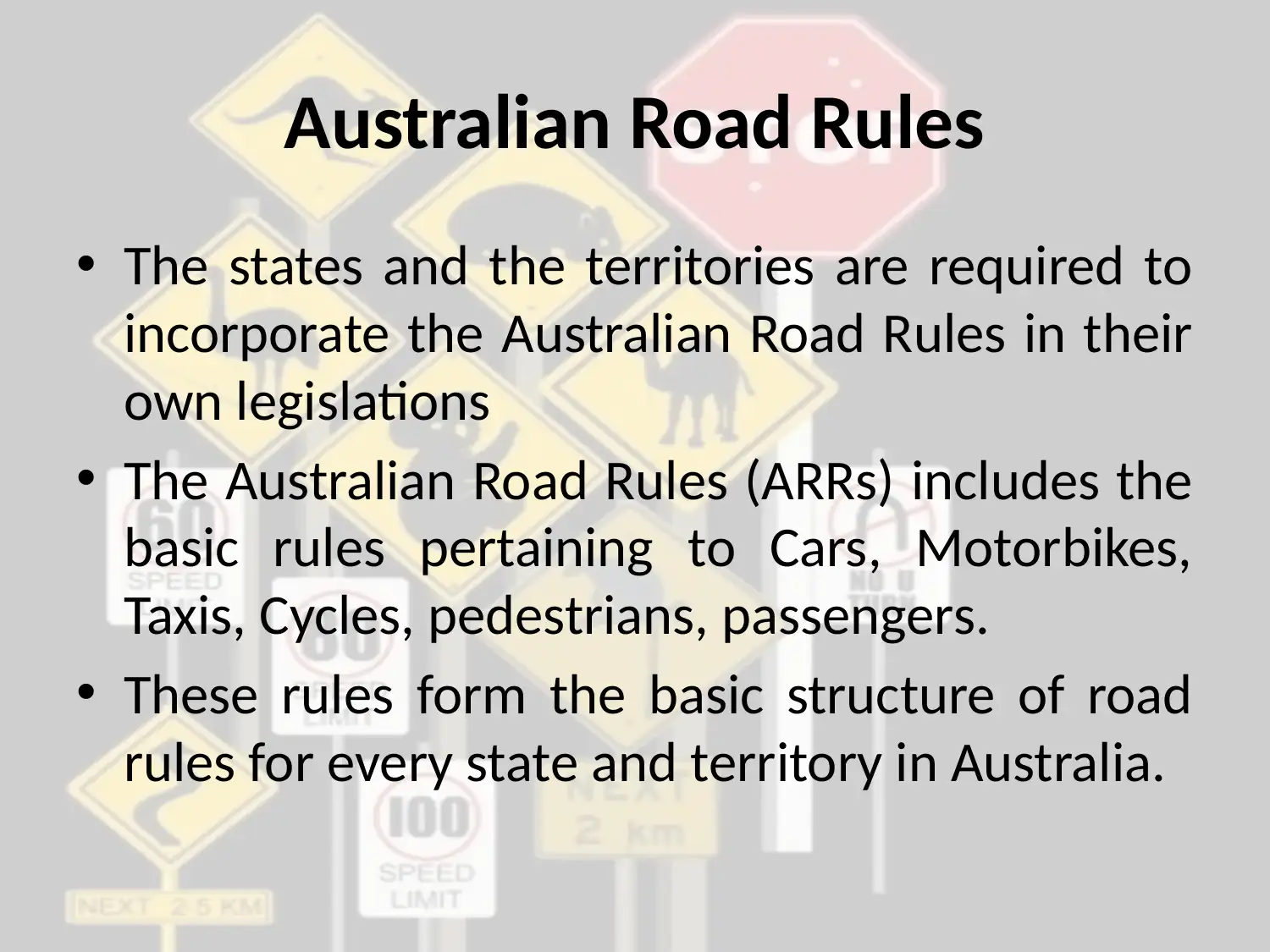
Australian Road Rules
• The states and the territories are required to
incorporate the Australian Road Rules in their
own legislations
• The Australian Road Rules (ARRs) includes the
basic rules pertaining to Cars, Motorbikes,
Taxis, Cycles, pedestrians, passengers.
• These rules form the basic structure of road
rules for every state and territory in Australia.
• The states and the territories are required to
incorporate the Australian Road Rules in their
own legislations
• The Australian Road Rules (ARRs) includes the
basic rules pertaining to Cars, Motorbikes,
Taxis, Cycles, pedestrians, passengers.
• These rules form the basic structure of road
rules for every state and territory in Australia.
Paraphrase This Document
Need a fresh take? Get an instant paraphrase of this document with our AI Paraphraser
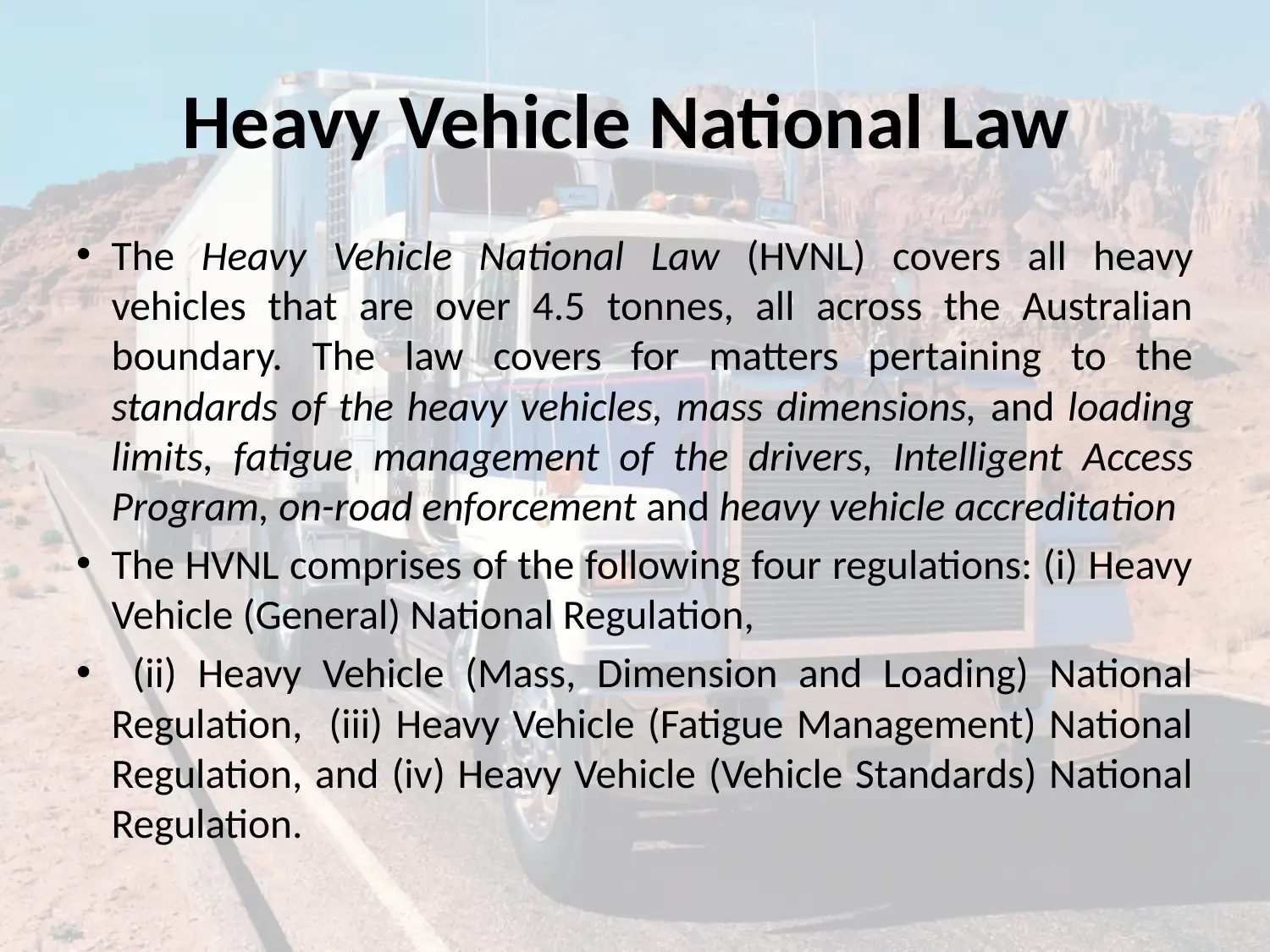
Heavy Vehicle National Law
• The Heavy Vehicle National Law (HVNL) covers all heavy
vehicles that are over 4.5 tonnes, all across the Australian
boundary. The law covers for matters pertaining to the
standards of the heavy vehicles, mass dimensions, and loading
limits, fatigue management of the drivers, Intelligent Access
Program, on-road enforcement and heavy vehicle accreditation
• The HVNL comprises of the following four regulations: (i) Heavy
Vehicle (General) National Regulation,
• (ii) Heavy Vehicle (Mass, Dimension and Loading) National
Regulation, (iii) Heavy Vehicle (Fatigue Management) National
Regulation, and (iv) Heavy Vehicle (Vehicle Standards) National
Regulation.
• The Heavy Vehicle National Law (HVNL) covers all heavy
vehicles that are over 4.5 tonnes, all across the Australian
boundary. The law covers for matters pertaining to the
standards of the heavy vehicles, mass dimensions, and loading
limits, fatigue management of the drivers, Intelligent Access
Program, on-road enforcement and heavy vehicle accreditation
• The HVNL comprises of the following four regulations: (i) Heavy
Vehicle (General) National Regulation,
• (ii) Heavy Vehicle (Mass, Dimension and Loading) National
Regulation, (iii) Heavy Vehicle (Fatigue Management) National
Regulation, and (iv) Heavy Vehicle (Vehicle Standards) National
Regulation.
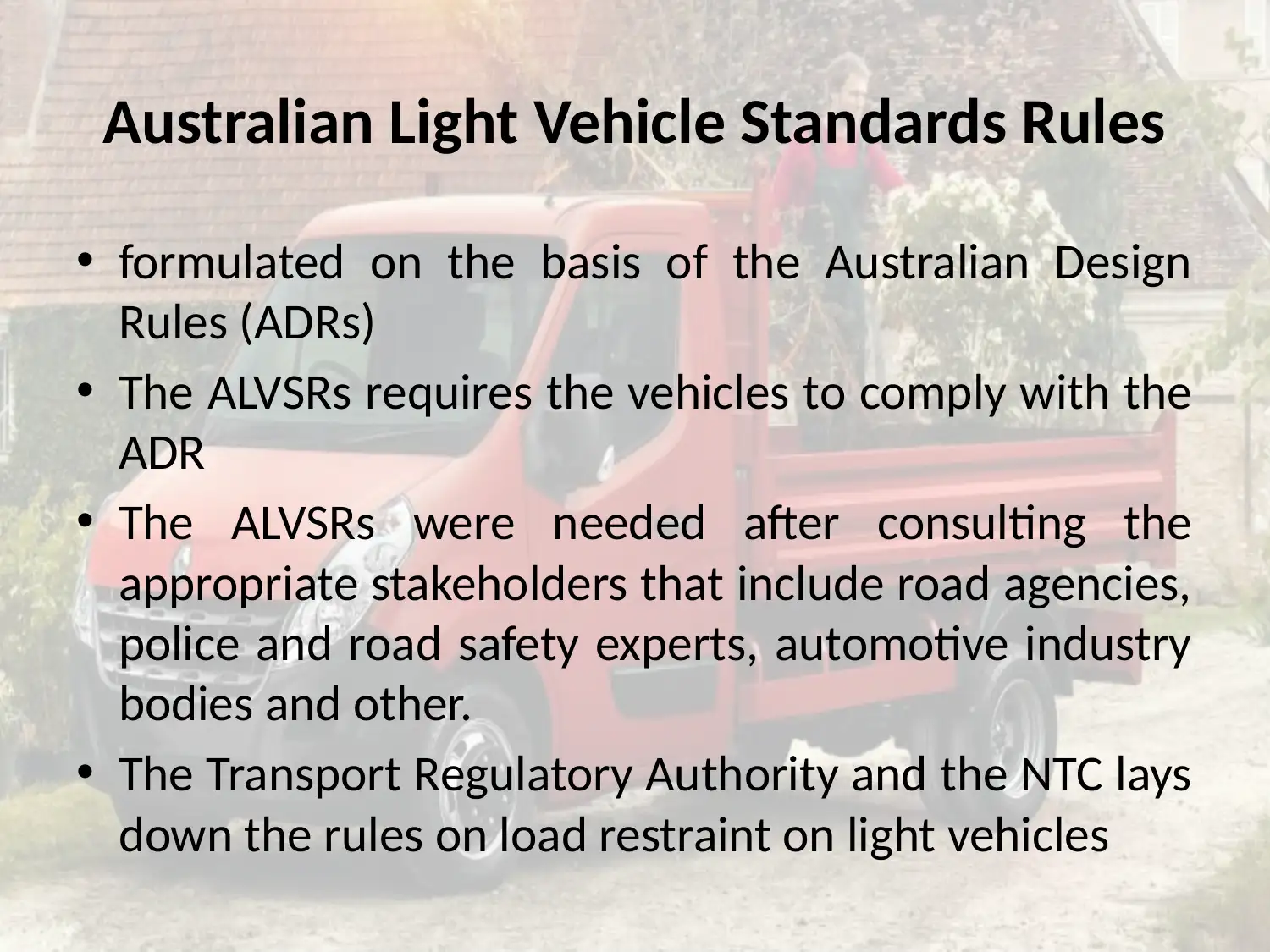
Australian Light Vehicle Standards Rules
• formulated on the basis of the Australian Design
Rules (ADRs)
• The ALVSRs requires the vehicles to comply with the
ADR
• The ALVSRs were needed after consulting the
appropriate stakeholders that include road agencies,
police and road safety experts, automotive industry
bodies and other.
• The Transport Regulatory Authority and the NTC lays
down the rules on load restraint on light vehicles
• formulated on the basis of the Australian Design
Rules (ADRs)
• The ALVSRs requires the vehicles to comply with the
ADR
• The ALVSRs were needed after consulting the
appropriate stakeholders that include road agencies,
police and road safety experts, automotive industry
bodies and other.
• The Transport Regulatory Authority and the NTC lays
down the rules on load restraint on light vehicles
⊘ This is a preview!⊘
Do you want full access?
Subscribe today to unlock all pages.

Trusted by 1+ million students worldwide
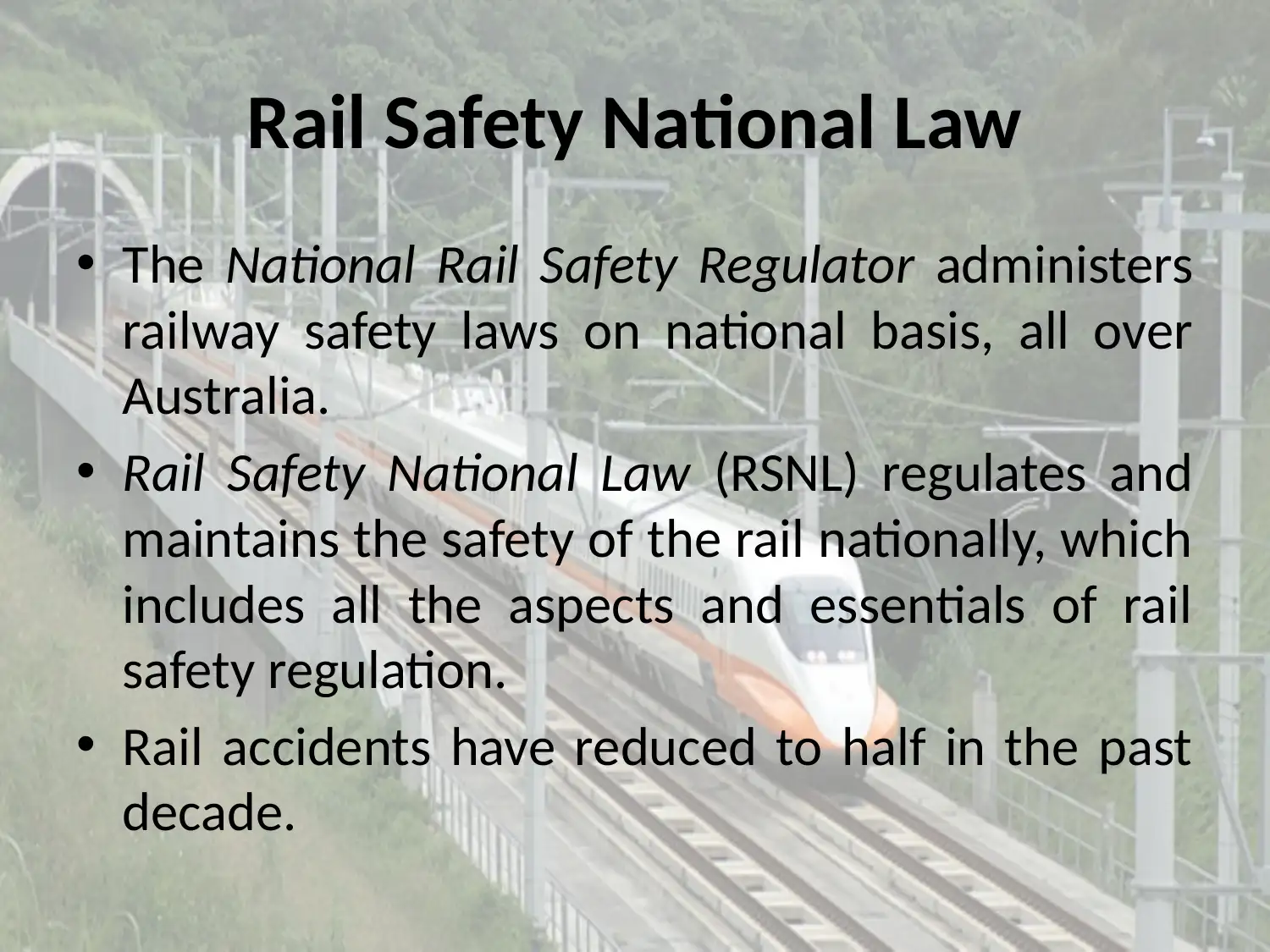
Rail Safety National Law
• The National Rail Safety Regulator administers
railway safety laws on national basis, all over
Australia.
• Rail Safety National Law (RSNL) regulates and
maintains the safety of the rail nationally, which
includes all the aspects and essentials of rail
safety regulation.
• Rail accidents have reduced to half in the past
decade.
• The National Rail Safety Regulator administers
railway safety laws on national basis, all over
Australia.
• Rail Safety National Law (RSNL) regulates and
maintains the safety of the rail nationally, which
includes all the aspects and essentials of rail
safety regulation.
• Rail accidents have reduced to half in the past
decade.
Paraphrase This Document
Need a fresh take? Get an instant paraphrase of this document with our AI Paraphraser
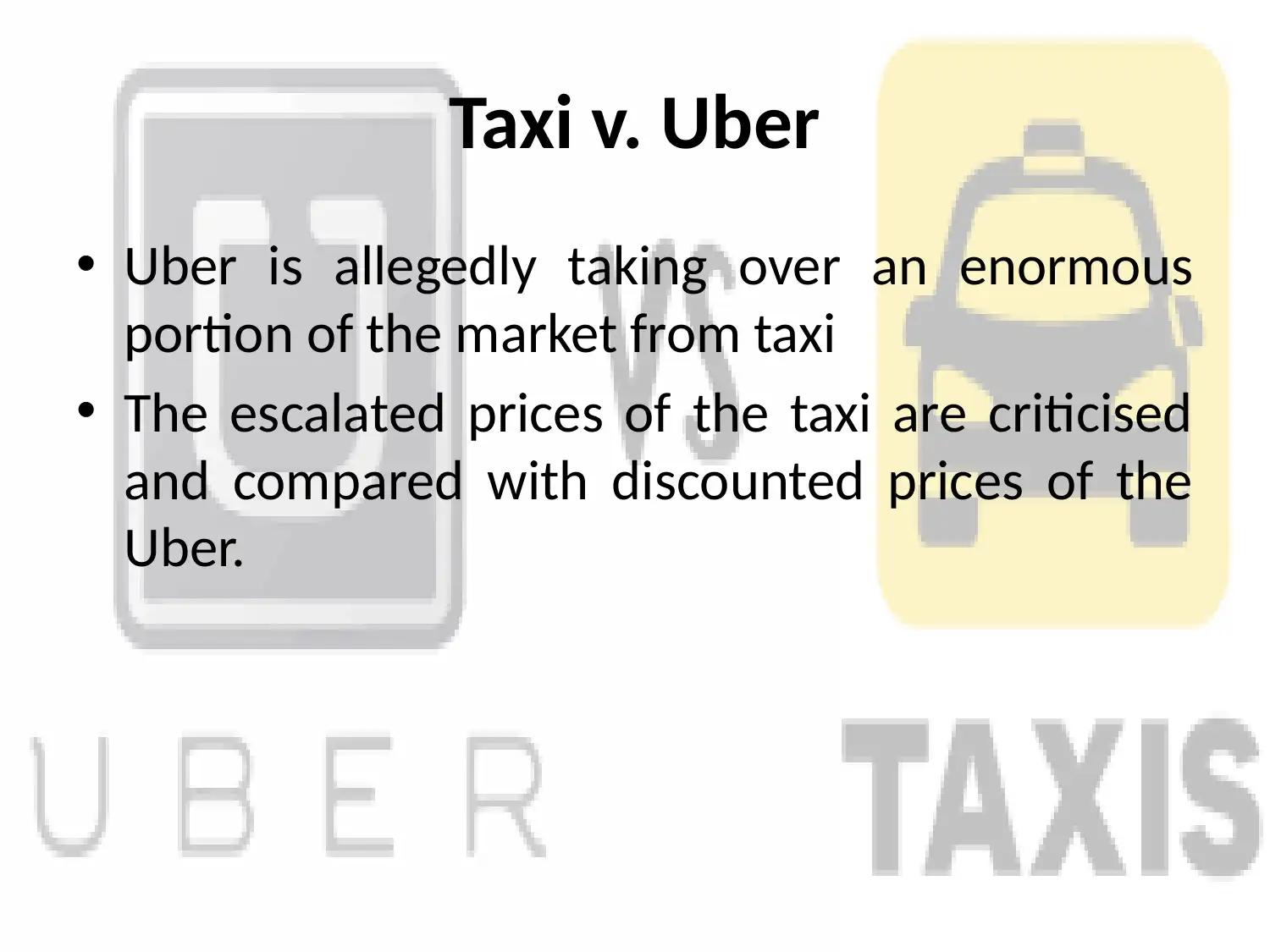
Taxi v. Uber
• Uber is allegedly taking over an enormous
portion of the market from taxi
• The escalated prices of the taxi are criticised
and compared with discounted prices of the
Uber.
• Uber is allegedly taking over an enormous
portion of the market from taxi
• The escalated prices of the taxi are criticised
and compared with discounted prices of the
Uber.
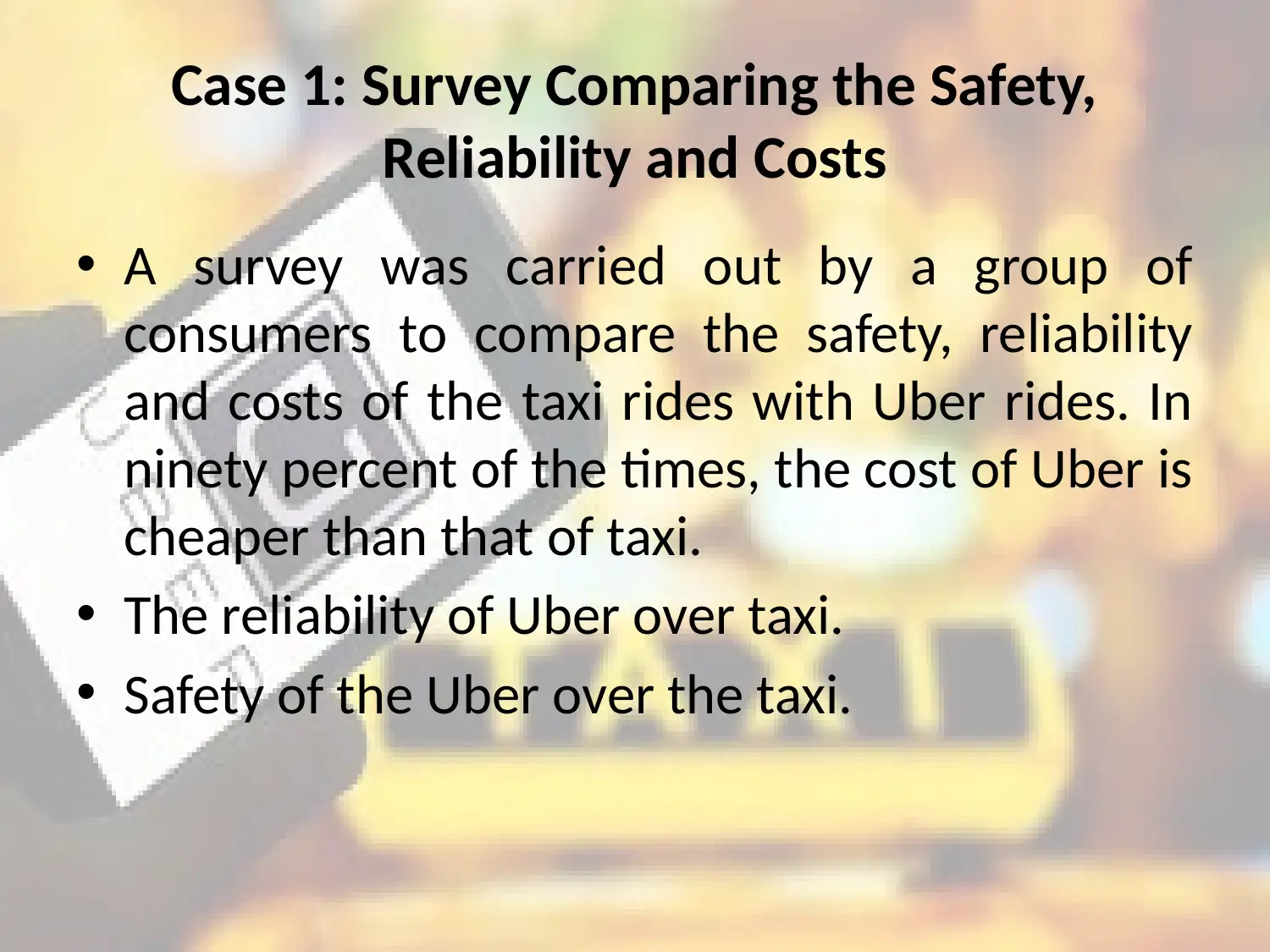
Case 1: Survey Comparing the Safety,
Reliability and Costs
• A survey was carried out by a group of
consumers to compare the safety, reliability
and costs of the taxi rides with Uber rides. In
ninety percent of the times, the cost of Uber is
cheaper than that of taxi.
• The reliability of Uber over taxi.
• Safety of the Uber over the taxi.
Reliability and Costs
• A survey was carried out by a group of
consumers to compare the safety, reliability
and costs of the taxi rides with Uber rides. In
ninety percent of the times, the cost of Uber is
cheaper than that of taxi.
• The reliability of Uber over taxi.
• Safety of the Uber over the taxi.
⊘ This is a preview!⊘
Do you want full access?
Subscribe today to unlock all pages.

Trusted by 1+ million students worldwide
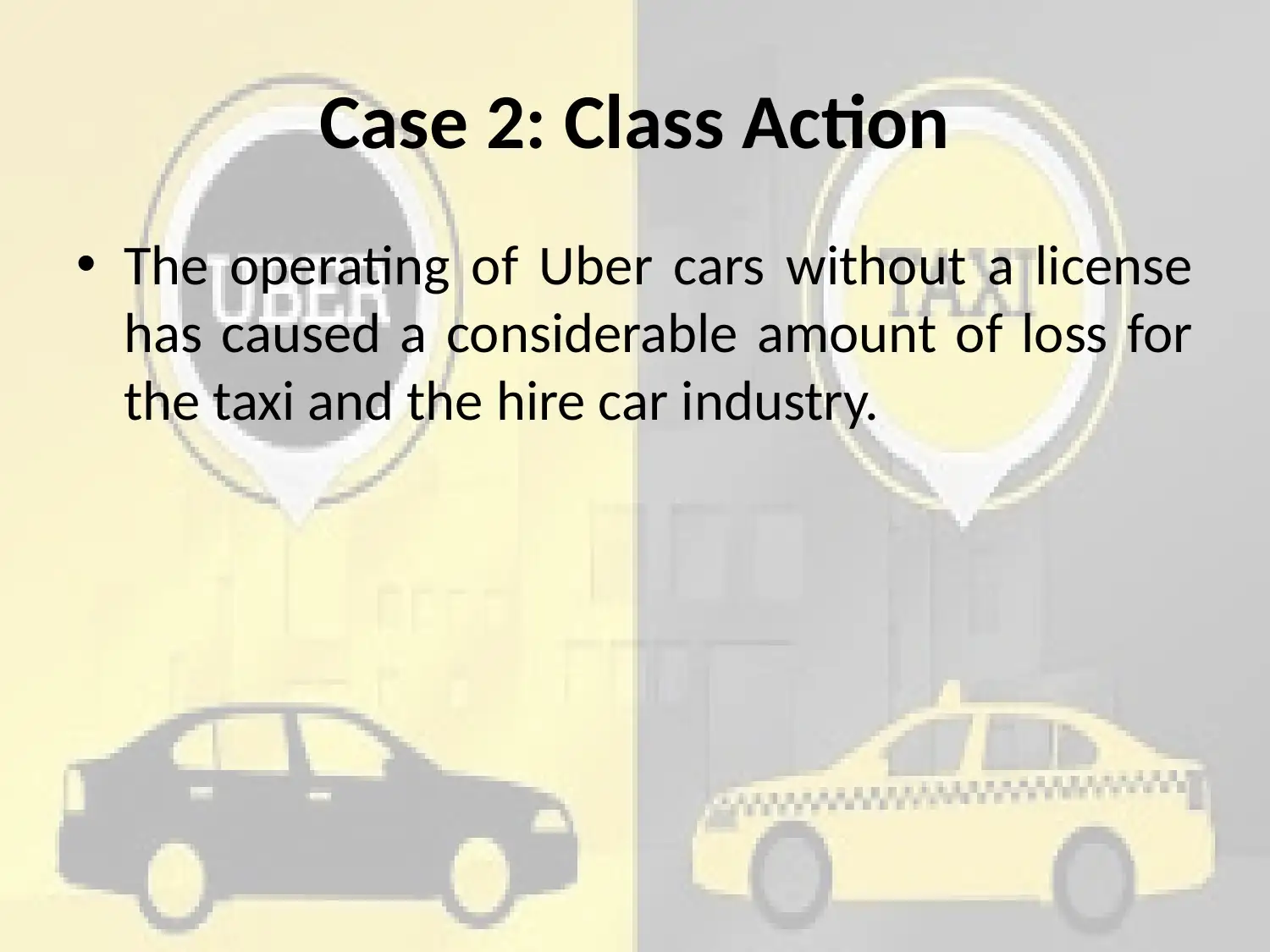
Case 2: Class Action
• The operating of Uber cars without a license
has caused a considerable amount of loss for
the taxi and the hire car industry.
• The operating of Uber cars without a license
has caused a considerable amount of loss for
the taxi and the hire car industry.
Paraphrase This Document
Need a fresh take? Get an instant paraphrase of this document with our AI Paraphraser
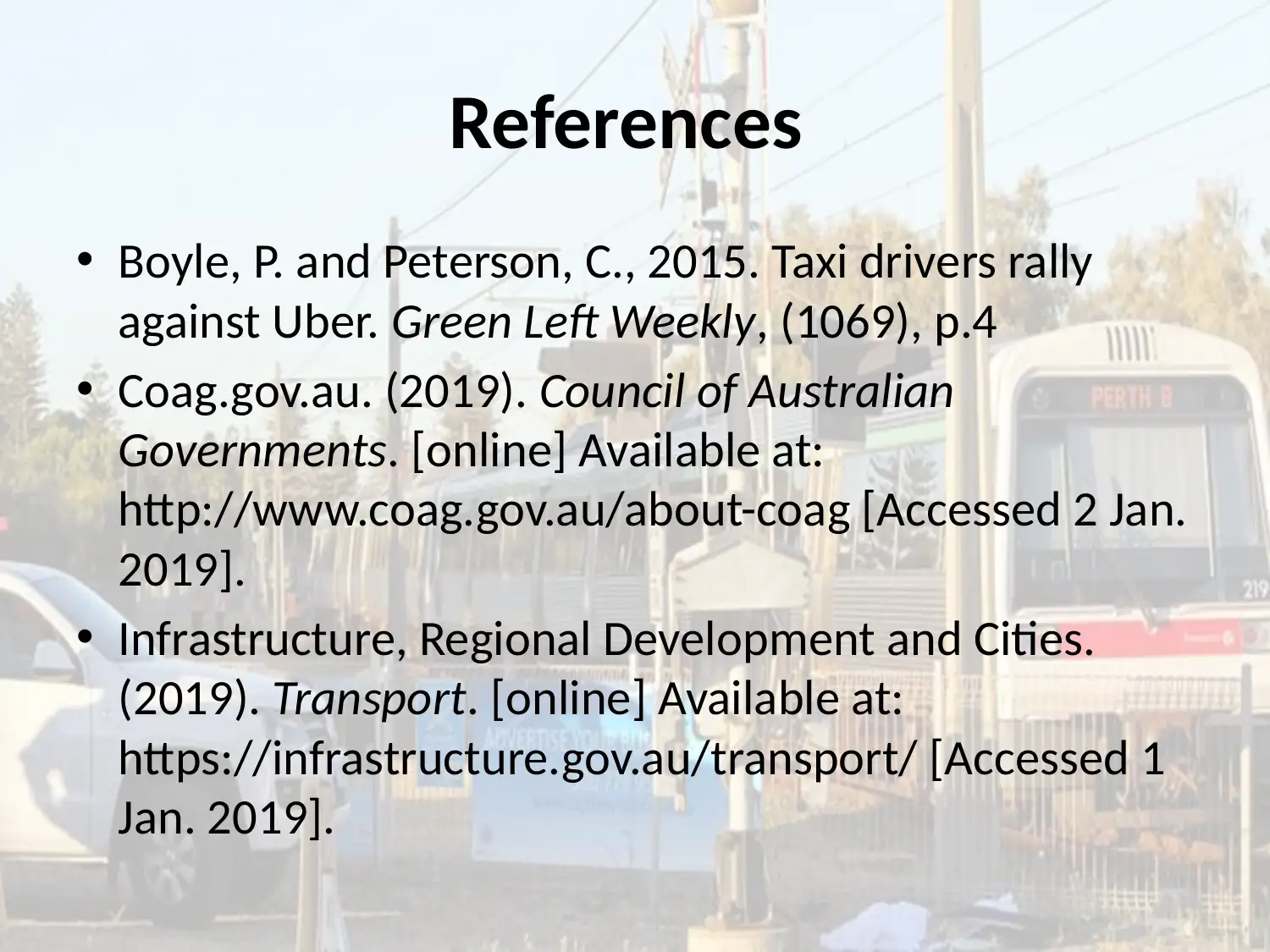
References
• Boyle, P. and Peterson, C., 2015. Taxi drivers rally
against Uber. Green Left Weekly, (1069), p.4
• Coag.gov.au. (2019). Council of Australian
Governments. [online] Available at:
http://www.coag.gov.au/about-coag [Accessed 2 Jan.
2019].
• Infrastructure, Regional Development and Cities.
(2019). Transport. [online] Available at:
https://infrastructure.gov.au/transport/ [Accessed 1
Jan. 2019].
• Boyle, P. and Peterson, C., 2015. Taxi drivers rally
against Uber. Green Left Weekly, (1069), p.4
• Coag.gov.au. (2019). Council of Australian
Governments. [online] Available at:
http://www.coag.gov.au/about-coag [Accessed 2 Jan.
2019].
• Infrastructure, Regional Development and Cities.
(2019). Transport. [online] Available at:
https://infrastructure.gov.au/transport/ [Accessed 1
Jan. 2019].
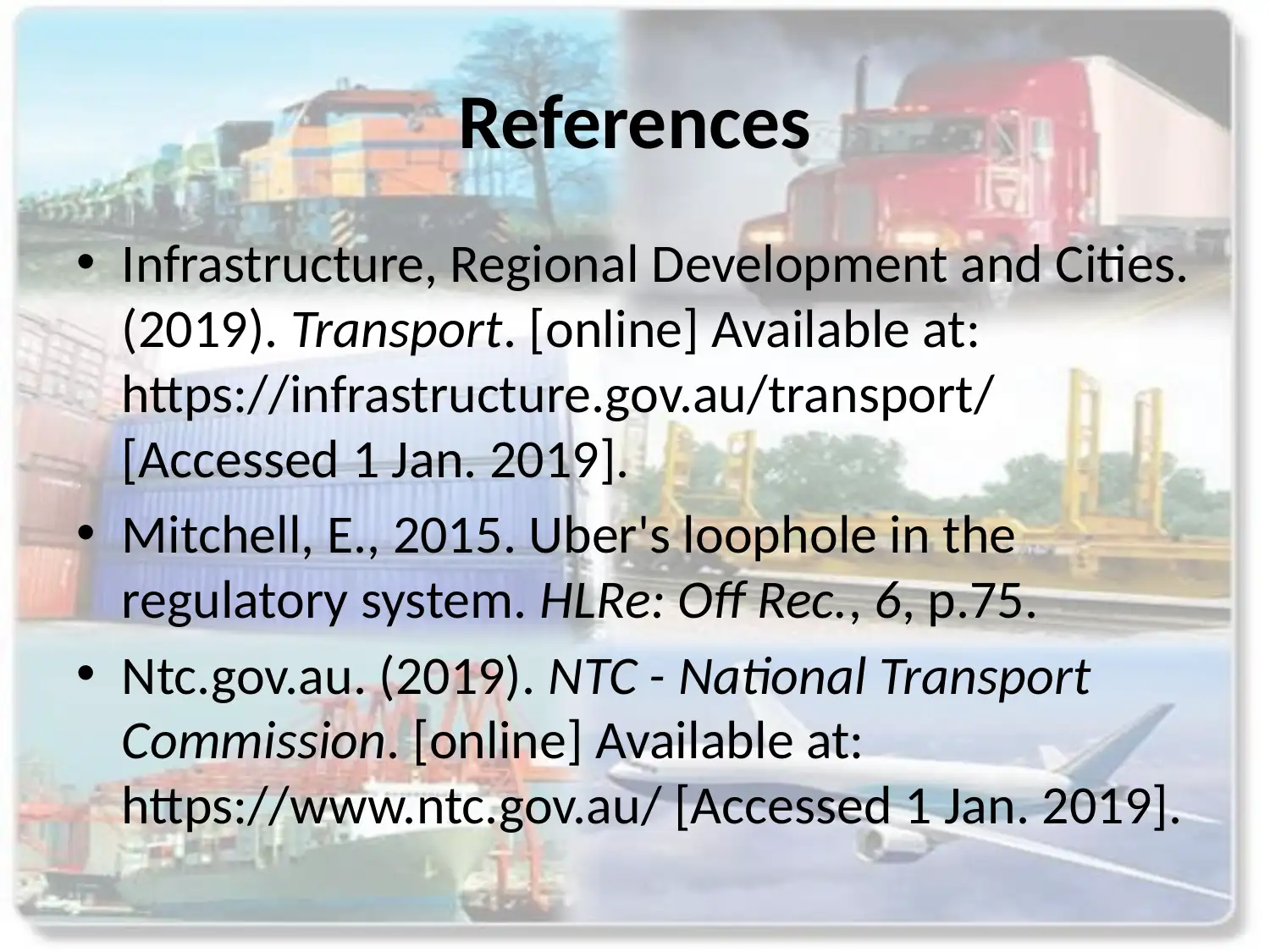
References
• Infrastructure, Regional Development and Cities.
(2019). Transport. [online] Available at:
https://infrastructure.gov.au/transport/
[Accessed 1 Jan. 2019].
• Mitchell, E., 2015. Uber's loophole in the
regulatory system. HLRe: Off Rec., 6, p.75.
• Ntc.gov.au. (2019). NTC - National Transport
Commission. [online] Available at:
https://www.ntc.gov.au/ [Accessed 1 Jan. 2019].
• Infrastructure, Regional Development and Cities.
(2019). Transport. [online] Available at:
https://infrastructure.gov.au/transport/
[Accessed 1 Jan. 2019].
• Mitchell, E., 2015. Uber's loophole in the
regulatory system. HLRe: Off Rec., 6, p.75.
• Ntc.gov.au. (2019). NTC - National Transport
Commission. [online] Available at:
https://www.ntc.gov.au/ [Accessed 1 Jan. 2019].
⊘ This is a preview!⊘
Do you want full access?
Subscribe today to unlock all pages.

Trusted by 1+ million students worldwide
1 out of 13
Related Documents
Your All-in-One AI-Powered Toolkit for Academic Success.
+13062052269
info@desklib.com
Available 24*7 on WhatsApp / Email
![[object Object]](/_next/static/media/star-bottom.7253800d.svg)
Unlock your academic potential
Copyright © 2020–2025 A2Z Services. All Rights Reserved. Developed and managed by ZUCOL.



